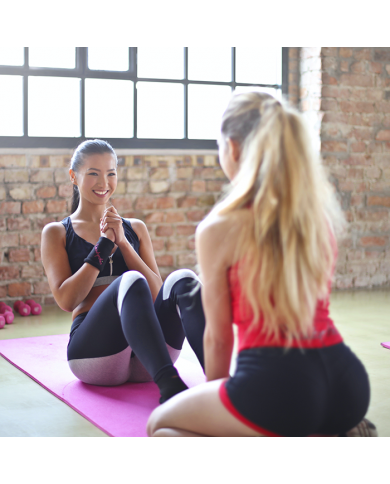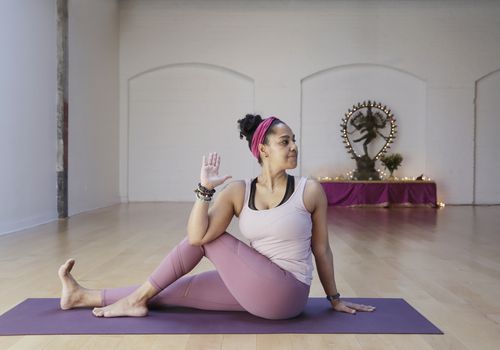
Although it may seem hard to practice yoga for back pain, it is a great way to avoid back aches. We'll be looking at Sphinx Pose and Child's Pose. Each pose is different and focuses on different parts. If your back isn't as flexible as you'd like, a yoga belt can help you reach your toes.
Sphinx Pose
Sphinx poses are great for strengthening the spine, and opening up restricted areas of your back. Start by placing your thighs directly behind you, and your elbows beneath your shoulders. You can exhale to lift through the crown and lower back. You can bring your torso to neutral in ten to 15 breaths. Then, repeat the exercise five to ten additional times.

You can also practice the Sphinx Pose for back pain to condition your back after a spinal surgery. This is a beginner-friendly yoga pose that strengthens the shoulders and lower back. This pose can be done by pregnant women who press their forearms against the wall. It is also a great way to stretch the chest and shoulders and can lead to more difficult back-bending poses.
The Child's Poses
Child's Pose can be a great way for back pain to go. Known as the prayer stretch, this yoga pose stretches the muscles of the spine and lower back. Begin by lying on your back with your hands and knees under your shoulders. Start by laying on your back, keeping your hands under your shoulders. Next, spread your arms in front and place your palms forward. This can be held for as long or as little as you like.
Child's Pose should be performed with care. You must also check for any injuries and conditions that could affect the spine. If you have a disk problem, you should avoid performing it or seek advice from a healthcare professional. Once you are comfortable, pillow yourself and slowly progress. Avoid pushing yourself too far as back pain can lead to more injury. If you are not comfortable with Child's Pose, try another pose until you find a comfortable position.
With clasped hands, stand forward and fold your arms.
The Forward Fold (also known as the Standing Forward Fold) is a very basic asana. It relieves tension from the back and opens the shoulders. It increases blood circulation and oxygenation of the brain. It also opens up the neck and shoulders. It is a good posture practice for back pain because it stretches the entire back. Stress and back pain can be relieved by standing up straight with your hands clasped.

This is a very popular asana in the Yoga Journal's Pose Library. With expert insights from yoga teachers and videos of how-to guides, you can practice this pose safely and efficiently. This pose calms your brain and stimulates your liver, while simultaneously stretching your hips and calves. It is thought to be one the most relaxing poses, and it can aid in insomnia. For beginners, however it is important to practice slowly and correctly.
FAQ
Are you able to do yoga with your hands?
It depends on the kind of yoga that you are doing. Some styles of yoga require flexibility. Others focus on muscle strength.
Different types of yoga call for different levels and degrees of flexibility. Beginners may need to only stretch their arms overhead. Whereas intermediate practitioners may need to bend forward and touch their toes. Advanced practitioners may be required to do deep twists and turns.
Are there any side effects to yoga?
Yoga poses some risks, as with all physical activities. The most serious risk is injury. The main risk is injury.
If you are just beginning yoga, you might feel dizzy when standing on the head.
This is caused due to blood clotting in your brain. But don't worry; the sensation disappears quickly.
Do downward-facing dogs if you experience chest pains. Don't hold your breath. It will only make the situation worse and increase your heart rate.
Is yoga a sweaty sport?
It depends on the type of yoga that you practice. Vinyasa flow (or power) yoga involves lots of jumping, twisting, and turning movements. People often sweat heavily while practicing yoga.
Hatha yoga, however, is focused on forwarding twists and bends. The poses aren’t particularly strenuous so practitioners won’t experience excessive sweating.
How long does it take to learn yoga?
Yoga is a lifelong endeavor that requires dedication as well as patience. Learning new things takes everyone at their own pace.
It doesn't really matter what age you are. You can master any routine of yoga if there is enough dedication and hard work.
Do I need to warm up before doing yoga?
No. It is not necessary to warm up before you begin a session of yoga.
However, if your muscles are stiff or sore, stretching them before exercising can help loosen them up.
What happens to your body if you do yoga every morning?
You will feel calm, relaxed and centered. It improves balance, posture, and flexibility.
You will become more aware and conscious of your body, how it feels when moving. You become more aware and conscious of your body.
Yoga improves concentration.
Your mind will be sharper and clearer. It calms you nervous system. It lowers stress levels. It also gives you a sense if peace and well being.
What is the main difference between yoga, pilates, and other exercise?
Both pilates, and yoga, are both effective exercise programs. However they work differently. Both involve stretching, but pilates focuses on postures that challenge your core muscles while building strength.
Pilates emphasizes balance and strengthening core muscles. It's important to note that yoga can be used to complement pilates workouts.
Statistics
- Start your Fall off right with 20% off All Access Membership when you sign up by 9/25! (corepoweryoga.com)
- The people in the yoga group were 37 percent more likely to have quit smoking by the end of the 8-week program. (nccih.nih.gov)
- About one in seven U.S. adults practiced yoga in the past 12 months, according to a 2017 national survey. (nccih.nih.gov)
- In comparison, a 125-pound person is estimated to burn 135 calories in 30 minutes of walking (at a pace of 15-minute miles) and 210 calories bicycling at a moderate pace on a stationary bike. (everydayhealth.com)
- A 2020 review of 27 studies (1,805 total participants) of yoga interventions in children or adolescents found reductions in anxiety or depression in 70 percent of the studies, with more promising results for anxiety. (nccih.nih.gov)
External Links
How To
What is the best position to practice yoga?
There is no one right way to do yoga. Every person has their own style. It is enough to find the position that feels most comfortable for you.
Here are some common poses:
Standing poses - Standing poses are suitable for beginners because they allow you to see how your body looks from different angles. They also make it easier to focus on breathing.
Forward bends- Forward bends can often be used to release tight areas. You can do them sitting down or lying down.
Backbends-Backbends are generally considered advanced poses. Ask your instructor for advice if you're interested in trying it.
Inversions – Inversions require you to balance upside down. This type is challenging, but rewarding.